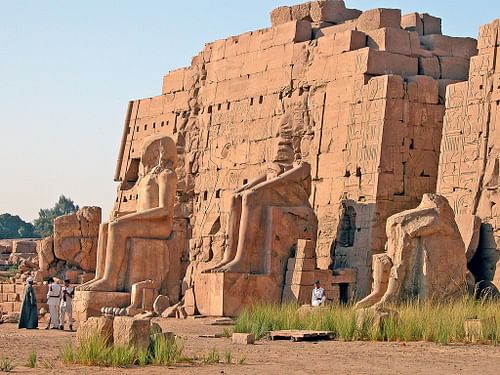Ancient Egypt: "An Old Civilization Recorded in History - Egyptian Eternity"
History of Ancient Egypt

People settled in Egypt as early as 6000 B.C. Over time, small villages joined together to become states until two kingdoms emerged: Lower Egypt, which covers the Nile River Delta up to the Mediterranean Sea in the north, and Upper Egypt, which covers the Nile Valley in the south. The Nile River flows from south to north, so for the ancient Egyptians, the southern part of the country was "up."
Around 3100 B.C., a king (later called a pharaoh) united these two lands to be one country, and so historians begin the long history of ancient Egypt here, dividing it into different periods.
1. Early Dynastic Period, about 525 years (ca 3100 B.C. to ca 2575 B.C.):
These early pharaohs worked to keep the two lands under their control. To do this, they claimed they were being watched over by the falcon god Horus, so the people of Egypt should respect them. They also used record keeping in the form of hieroglyphic writing to record things like royal decrees and the taxes that the people paid in the form of grain.
2. Old Kingdom, about 425 years (ca 2575 B.C. to ca 2150 B.C.):
By this time, the pharaohs had enough power and wealth to build pyramids in their honor; that’s why the Old Kingdom is sometimes called the “Age of the Pyramids.” The pharaohs at this time were primarily associated with the sun god Ra, a tradition that would remain for much of Egypt’s history.
3. First Intermediate Period, about 200 years (ca 2130 B.C. to ca 1938 B.C.):
These pharaohs lost power after drought hit Egypt. Instead, local leaders took control of their own communities, and they stopped passing along grain to the central government. Eventually, these local rulers formed independent states.
4. Middle Kingdom, about 300 years (ca 1938 B.C. to ca 1630 B.C.):
5. Second Intermediate Period, about 90 years (ca 1630 B.C. to ca 1540 B.C.):
6. New Kingdom, about 465 years (ca 1540 B.C. to 1075 B.C.):
7. Third Intermediate Period, about 420 years (ca 1075 B.C. to ca 656 B.C.):
8. Late Period, about 300 years (ca 656 B.C. to 332 B.C.):
This period marks the last time that ancient Egypt was ruled by native Egyptians. King Darius I took control by leading an army from Persia (what is now Iran).
9. Macedonian and Ptolemaic Egypt, about 300 years (332 B.C. to 30 B.C.):
Life in Ancient Egypt
Most people in ancient Egypt were farmers. They lived with their families in houses made of mud bricks that were near the Nile River.
During flood season, farmers couldn’t tend their crops. So instead, some worked building pyramids, tombs, and monuments. Other people worked as scribes (people who recorded events), priests, and doctors.
Women in ancient Egypt had more freedom than those in other ancient cultures. Like men, they could be scribes, priests, and doctors, and they usually had the same rights as men. Women could own their own homes and businesses.
Ancient Egyptians also like to have fun! They swam and canoed in the Nile, played board games, and they enjoyed making music and dancing.










Comments
Post a Comment